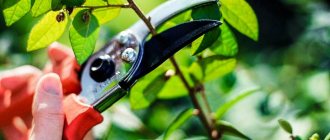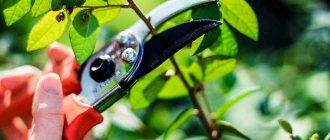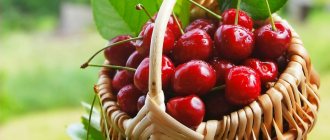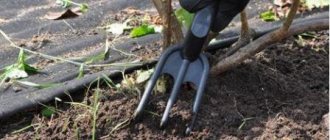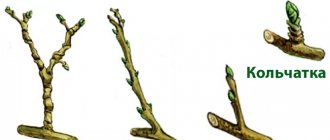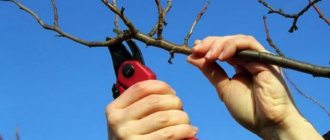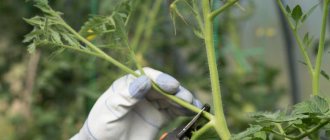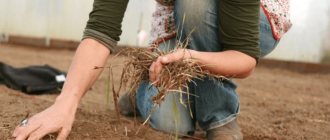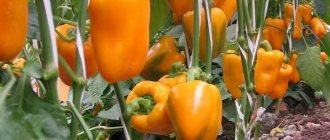Remontant raspberries are a favorite of many gardeners, because this berry crop is hardy, disease-resistant, does not require special care, and its fruits have high taste. Proper handling of this plant will allow you to harvest abundant harvests during the “extended” season. The main conditions for raspberries to delight us with their berries for as long as possible are the correct selection of varieties, taking into account zoning, and the correct cultivation of horticultural crops, taking into account the local conditions of specific regions.
Why prune raspberries in the fall?
The first reason is the removal of old shoots. Raspberries have a two-year fruiting cycle. In the first spring, trunks are formed, and the next year berries appear on them. After fruiting, they gradually dry out under the pressure of young growth.
The second reason is the thickening of plantings. It has been noticed: the more branches there are in the bush, the smaller the berries. There are more insects in dense raspberry forests. Productive varieties run wild without pruning - the taste of the berries deteriorates. When raspberries are left with a few stems, they receive adequate nutrition. It is convenient to harvest when there are no dense thickets. If the rows are visible, all the berries are visible.
Timing for pruning raspberries in autumn
The time for autumn pruning of raspberries depends on the climatic characteristics of the region. The beginning of autumn is considered the most successful time, but this concept is flexible. You can take up the pruning shears immediately after picking the last berries.
Recommended dates for autumn pruning by region:
- southern regions - from the end of July to the first week of October;
- central Russia - last week of August - mid-September;
- Ural, Siberia, other areas of risky agriculture - August;
- northern regions - mid-August - early September, work must be carried out as soon as possible.
It is more convenient to work with raspberries on dry days. The soil will warm up, the branches will dry out, and will yield better to the blades. If the plantings are large, you can work on them for several days. The main thing is to give the plants a rest before wintering.
Autumn pruning is called so conventionally. Gardeners get rid of excess young growth in raspberry fields throughout the summer, when they loosen the soil and free it from weeds. The tops of young branches that are too elongated are pinched during fruiting, the berries are collected every three days, otherwise they will all end up on the ground. If you want to grow strong raspberry trees, you should care for them regularly.
Optimal timing
Pruning raspberries too early can cause the growth of shoots. Here you need to be guided by the principle: better later than earlier. This operation is optimally carried out with the onset of regular frosts.
In the Moscow region and central zone
In this region, gardeners and vegetable gardeners have enough time to do autumn work in their dachas.
Typically, pruning of shrubs begins when the plant sheds its leaves. At this time, they no longer supply the roots with food.
But many prefer to hold it in October and the first half of November. The main thing is to make it before frost.
In the Urals
In the Urals, raspberries begin to be prepared for winter in September
Even in the Southern Urals, frosts begin in early September. This means that the growing season is over and it's time to prepare for winter.
Remontant raspberries are pruned in August, and completely, at the root.
If you delay the procedure, you may lose the bush altogether:
- the stems are dry and brittle due to lack of moisture in the soil;
- frosts up to 30° can occur even at the beginning of winter;
- lack of snow cover.
Fragile stems cannot be bent to the ground and sprinkled even a little with snow, as a result of which unpruned shoots will freeze and the entire plant will die.
In Siberia
Even in the warm Altai region, frosts occur already at the end of August. This means we need to prepare for winter.
In Siberia, the last days of summer are the best time for pruning. At this time, the crop has already borne fruit and the leaves fall off.
If the autumn turned out to be very warm, you can slightly shift the dates to the beginning of September, but be sure to make it before the first ground frosts. The Siberian winter is harsh, so the roots of even winter-hardy varieties can suffer.
Let's summarize: the Urals and Siberia are not suitable for growing remontant raspberries. Even in a one-year cycle, there is a high risk of not meeting the growing season. But still, you shouldn’t give up and give up the double harvest of this berry.
If for some reason it was not possible to prune in the fall, it can be done in the spring. But here the time frame is narrower - this must be done before the start of sap flow.
According to the lunar calendar
Depending on the phases of the Moon, the parameters of processes in living organisms change:
- metabolic rate;
- susceptibility to disease;
- survival rate of transplanted plants;
- Tolerance to cuts and wounds.
On the waxing Moon, the above-ground part (stems, leaves, flowers, fruits) is actively growing. It is not recommended to prune during this phase; at this time, injuries to the stems can cause disease.
On the decreasing part, the underground part develops (roots, bulbs, tubers). Therefore, the procedure is absolutely safe.
Pruning is best done on a waning moon.
The new moon and full moon are the periods when plants are most vulnerable. On such days it is dangerous to prune raspberries. But the day before the new moon and the day after it is a good time to remove damaged and diseased plants and wild growth.
To find out the phase, you can refer to the calendar. For each day, the necessary information is indicated there. There are also special, zoned lunar calendars for gardeners.
In 2022, the most favorable days for pruning are:
- August - 16-29;
- September - 15-27;
- October - 15-27;
- November - 13-25.
Shoot height
Pruning raspberries in autumn - picture
Stems with brown trunks and thickening shoots are cut out to the very roots. Place the pruning shears at ground level or slightly deeper. If you leave hemp above the surface, insects and pathogenic bacteria will settle in them. The remaining branches are usually shortened to 2 meters to make it convenient to pick berries, but at what height to cut raspberries in the fall, you should also choose the type of berry.
Tops that are too elongated are cut off to stimulate the formation of lateral processes. There are many inflorescences on them. The sooner you pinch them, the better the trunks will branch. Some productive varieties produce the main harvest on the lateral shoots.
Rules and methods of pruning
Remove to ground level:
- 2-year-old branches with berries on them;
- crooked and damaged young shoots;
- thickening tree trunks (thinning out bunches).
Novice gardeners mistakenly trim the edges of a raspberry bush in the fall, leaving the center untouched. The yield from such a “haircut” does not increase significantly. It is necessary to leave 5-7 branches around the entire circumference of the raspberry, be sure to thin out the middle so that the plantings are ventilated and the flowers will be well pollinated.
It is important to prepare the tool: the cutting surfaces are disinfected so that viruses do not get into the trunks, leading to disease and even death of the plant.
Basic rules for pruning raspberries in the fall:
- the remaining branches should be arranged like a fan, then they will not overlap each other;
- First, the rough two-year-olds are removed, then the soft young ones are cut out;
- broken, damaged branches are not left, they are removed at the root;
- shoots that appear in mid-summer are plucked out at the base; they will freeze and will not have time to ripen.
Trimming methods:
- formative: fast-growing varieties are pruned by 1/3;
- sanitary: removal of old and diseased branches;
- usual - getting rid of thickening, broken, two-year-old branches.
Pruning remontant raspberries in autumn
Pruning remontant raspberries in the fall - photo
Remontant raspberries, which bear fruit until late autumn, are in no hurry to prune; they are waiting for the last berries to ripen. They also appear on annual shoots. After the last wave of raspberry fruiting and shedding of foliage, 2-year-old bushes are cut out at the root, and the tops of annual bushes are cut off by 15–20 cm.
You should not spare one-year-old branches; after pruning, they will have time to lay new buds. In the spring they will immediately give growth not only upwards, but also on the sides. If you prune remontant varieties as usual, the yield will decrease. It is best to do remontant plantings separately from other species. Then there will be no confusion. From young shoots, no higher than 60 cm, leave no more than 3 strong branches. The rest is mercilessly removed, preferably from the roots. Proper pruning increases next year's harvest.
How to trim correctly
Scheme
Depends on the growing method.
One-year cycle
After the end of fruiting, all bushes (and shoots) are cut out at the root.
In the spring, new shoots will emerge from the roots, which will go through all stages of vegetative development in one season. This is followed again by complete pruning of all bushes.
Advantages of this method:
- ease of plant care;
- effective disease prevention;
- less risk of damage from insect pests.
In order to have fresh berries for as long as possible, regular raspberries are grown in parallel with remontant ones. An early harvest is taken from it.
Two-year cycle (in the south)
Second year stems can be cut back after they have been harvested to free up space and give first year shoots additional access to sunlight. They will develop more intensively.
But there are also disadvantages here. Even after picking the berries, vegetative processes in two-year-old stems continue. They continue to produce and store nutrients for the next season for the entire plant.
General recommendations
Raspberry stems should be removed at the very root, leaving a stump of minimal height. This should be done with disinfected sharp pruning shears. A blunt instrument will weaken the branch, which can cause fungal disease in the plant.
In order not to injure shoots of different diameters, various tools are used - this could be a lopper or a garden saw.
To reduce the risk of rotting of the cut, it is made obliquely towards the outside of the shoot.
It is not necessary to lubricate the cuts. For raspberries, this is a natural process; its internal disinfectants are able to defeat a small amount of pathogenic microflora. In the wild, branches are constantly broken off by snow, wind or animals - and do not get sick after that.
If the weather is damp, then it is better to treat large sections with garden varnish or drying oil-based paint. This way it will be calmer and fungi won’t get inside.
Further preparation for winter
Work on the berry patch continues. The plant needs to be fed so that it has enough strength to prepare for winter. The soil needs to be saturated with moisture; succulent shoots tolerate frost better. The ground is cleared of cuttings and weeds. Mulching is done to retain moisture. It is worth telling about each operation in more detail.
Proper feeding
Removing unnecessary branches is not the final stage of preparation for winter; you still need to know how to feed raspberries in the fall after pruning.
In the fall, after pruning, add some natural ingredients:
- Manure is incorporated into the soil in a thin layer. The unrotted one performs the function of biofuel and gives heat to the roots. Last year's is a source of nutrients. The most useful manure is horse manure, followed by cow manure. It is better not to place pork with sawdust on raspberries; first they let it rot well.
- Chicken droppings in their pure form burn plants. It is diluted in water at the rate of 200 mg per bucket.
- Compost is more valuable in nutritional value than humus; it is laid out in a layer of 5–7 cm around the shoots. The norm per 1 m2 is up to 7 kg (this is a bucket of dry).
- Take rotted peat, mix it with wood ash, add a glass to a bucket.
After feeding, raspberries replenish their reserves of nutrients and lay flower buds. Per 1 m2 add 40 mg of superphosphate and 20 mg of potassium sulfide. These comprehensive supplements contain essential macronutrients.
Sanitation
Spraying with fungicides protects against fungal diseases, rot, and mosaic. Bordeaux mixture is effective against insects. It is advisable to carry out the treatment before the foliage has completely fallen. Liquid laundry or green soap is added to the solution for better adhesion.
Watering
Usually by the end of summer in temperate latitudes it begins to rain, then watering is not required. If August turns out to be dry, the soil is well watered so that it is saturated to a depth of 40 cm. With the onset of frost, watering is reduced. During this period, the shoots will become woody and gain the necessary strength.
Mulching
Mulching serves to protect the roots from extreme cold until permanent snow cover has established. For mulch use:
- dry humus;
- rotted sawdust;
- straw;
- crushed bark.
Cover the soil with a layer of up to 8 cm. It has been proven that this is enough to prevent the ground from freezing to a great depth. In the northern regions, the layer is doubled; only in the spring, after the snow has melted, it is important to clear the mulch in time, otherwise the trunks will prop up and crack from below. It is recommended to add fresh pine needles to the mulch to repel mice.
Frost protection
When is it better to cover raspberries well:
- if it is a productive sugary variety, such berries are heat-loving;
- severe frosts are expected;
- winters with little snow;
- if the raspberry is thornless, it will become easy prey for rodents.
Proper preparation consists of bending the shoots to 1/3 of the height. As soon as the morning performances begin, you can sprinkle the prepared rows with spruce branches. It is convenient to tie branches to wooden pegs; you can drive nails into them on all sides. The end of the twine is wound onto the shoots and pulled down, bending them at an angle of 60°.
Bushes are protected from rodents with netting, barbed wire or spruce branches, and poisonous baits are laid out on cleared ground. Residents of northern latitudes are advised to bend raspberries as low as possible and cover the shelters with tops and dry branches. In windy areas, snow protection is made - sheets of plywood or polycarbonate are installed on the leeward side.
The branches bend when the air temperature is above +10°C; in the cold they become fragile.
Aftercare
All cut branches must be destroyed
All branches and leaves must be collected and burned. Fungal spores and insect pests can nest in them.
When growing raspberries in a two-year cycle, one-year-old stems must be bent to the ground so that they are covered with snow in winter. This is especially important in cold regions.
After pruning and harvesting, the ground around the bushes is mulched. This:
- Insulates plant roots for the winter and suppresses the growth of weeds.
- In summer it helps to maintain the necessary moisture in the root layer of the soil. For raspberries, this is especially important, since its entire root system is limited to a layer of 15 cm.
Peat, sawdust, straw, and pine litter can be used as mulch. It is not recommended to use leaves and grass from the garden - there may be sources of disease there.
Reviews
Katya P: Do I need to prune raspberries in the fall? The clear answer is yes. In this way, I increase productivity in the new year, which is what I wish for you.
Andrey Ch: I started thinning out the raspberries in the fall, as recommended. I noticed results the very next year. There were fewer branches, but more berries were collected from them.
Marina N: I always cut raspberries in the spring, but once I tried them in the fall. I liked that in the spring time is freed up for gardening. As soon as I pick the last raspberries, immediately behind the pruning shears.
Stepan R: In the fall it is easier to identify unnecessary young shoots, they are not so strong. When you leave 5–7 pieces on a bush, the remaining branches branch more strongly and bloom more abundantly. Productive varieties run wild without pruning and the berries become small.
Shelter for the winter, protection from rodents
Remontant raspberries, or rather growing and caring for them in the autumn, also include measures to protect against rodents. Animals have nothing to eat in winter, so they are not averse to eating young shoots of the bush. To protect the shoots from pests, the area under them is covered with burlap. Animals are not able to chew through it. As an addition, you can build a fence from a fine mesh.

